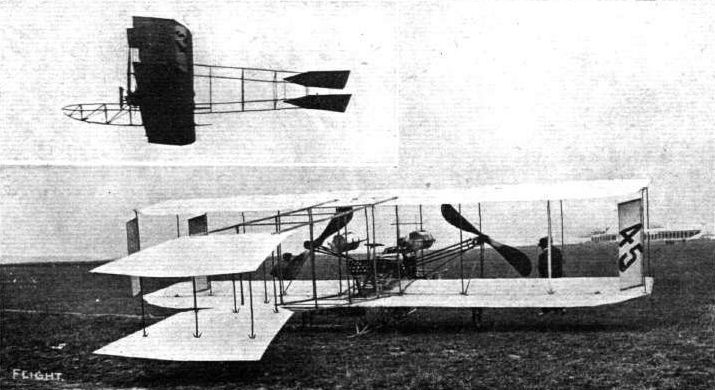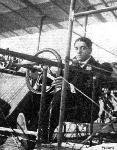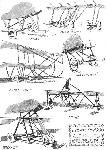Jane's All The World Aircraft 1913
SAVARY. Soc. anonyme des aeroplanes. Robert Savary, 31 rue Dunois, Paris. School: Chartres. Output capacity. 100 to 150 machines a year.
Model and date. 1912. 1912. 1913.
Biplane. Military Biplane.
(3-seater.)
Length..........feet(m.) 36 (11) 33 (10.15) 38? (11.70)
Span, upper.....feet(m.) 46 (14) 49 (14.90) 9? (15)
lower.....feet(m.) 33 (10) 37 (11.20) 33 (10)
Area.......sq. feet(m?.) 510 (48) 533 (50) 550 (52)
Weight, machine...
.............lbs.(kgs.) 1132 (600) ... 1132 (600)
Weight,useful...
.............lbs.(kgs.) ... ... ...
Motor...............h.p. various 0 Labor 75 Renault
(Gnome or Labor)
Speed,max....m.p.h.(km.) 56 (90) ... 59 (96)
min....m.p.h.(km.) 50 (80) ... ...
Number built during 1912 ... 47 ...
Notes.--Wood and steel construction. Control: ailerons and rear elevator. Landing gear: wheels and skids. Special features: There are 4 rudders in the gap, and 2 tractors, chain driven. Aeroplatte fabric.
Показать полностью
L.Opdyke French Aeroplanes Before the Great War (Schiffer)
Deleted by request of (c)Schiffer Publishing
When the Societe des Aeroplanes Robert Savary was incorporated in June 1910 at Neuilly, a western suburb of Paris, the assets included his patents from 1909, various subcontracts, and "a biplane." It was a Wright Flyer copy, built and tested at Leon Bollee's facility where Wilbur Wright had made his first European demonstrations. Savary's machine featured a biplane rear elevator, 2 pusher contra-rotating pusher propellers driven through one chain by a 40 hp water-cooled engine; there were 2 ailerons, and 2 flaps mounted vertically between the wingtips to control yaw. The pilot sat on the lower wing behind a large horizontally-mounted steering wheel. The motor was mounted to the pilot's right, behind a distinctive circular radiator.
(Span: 10 in; length: c 8 m; wing area: 44 sqm)
In 1910 a new Savary was shown at the Reims meeting, a much larger biplane. It retained Wright-style wings and there were now 4 vertical shutters hinged to each of the 2 rear outer wing struts. The biplane elevator cell was retained from his first aeroplane, but this time the engine, mounted on the lower wing behind a tall rectangular radiator, chain-drove 2 tractor contra-rotating propellers; the 2 pilots sat in tandem immediately behind the engine. The 2 castering main wheels were fitted under the trailing edge at the rear of a long uncovered structure of triangular section which served as forward fuselage and skid at one end and supporting skid at the other. The machine was rather heavy, a problem with all of the Savary designs.
(Span: 8.5 m; length: 9 m; wing area: 30 sqm; 60 hp ENV V8 driving the 2 Savary propellers at 500 rpm)
In 1911 his big 1910 design was modified: the large forward structure was replaced by a lighter unit to carry the central skid and rubber shock-absorbers attached by cables to the castering wheels. Ailerons were now built into all 4 wing panels. The control surfaces were hinged to the triangular tailplanes; the rudimentary fuselage nacelle was now covered and fitted behind the engine and the 2 chain-driven tractor propellers. 3 variants were built in 1911: a racer of 10-meter span, and a 2 - and a 3-seater; the latter 2 were entered in the 1911 Concours Militaire, each with overhung top wing panels and doubled wheels to meet the Concours requirements.
(2-seater: span: (upper): 14.5 m; (lower): 10 m; length: 11 m; wing area: c 52 sqm; empty weight: 600 kg; payload: 220 kg; speed: c 90 kmh; 70 hp water-cooled 4-cylinder inline Labor)
(3-seater: span: (upper): 19.5 m: (lower): 14 m; length: 12 m; wing area: c 69 sqm; empty weight: c 700 kg; payload: 420 kg; speed: c 90 kmh; 70 hp Labor)
Though the pilot Level was killed in the crash of the 3-seater, Joseph Frantz, who was later to be credited with the first air combat victory in 1914, managed so well with the 2-seater that the Army ordered 9 of them. One was delivered in 1911, the next in 1912, and the remaining 7 in 1913.
In 1912 Savary was offering for sale his 2 - and 3-seat military machines, a 2-seater with double controls for training, and a "type de course, long voyage, extra-leger" (a lightened long-range cross-country racer) all powered with the 70 hp Labor. The same year he tested one of his aeroplanes with propellers running without reduction-gearing, the engine set well ahead of the propellers; results were not satisfactory. All the 1912 designs were fitted with the rectangular nacelle of his 1911 models.
A seaplane with twin 3.7-meter Tellier floats and with retractable wheels was finished at the end of 1912. The vertical shutters were shorter with rounded corners, and a small semicircular rudder was fitted between the tail outriggers ahead of the biplane tail cell. The machine was wheel-tested at Juvisy on 2 January 1913, powered with a 75 hp air-cooled Renault, though it was later re-engined with Savary's favorite 70 hp Labor.
The basic Savary designs used various motors at different times. On 13 March 1913 Frantz flew 9 passengers on one of the twin tractor Savarys using a 110 hp Salmson Canton-Unne engine.
Показать полностью
J.Davilla Italian Aviation in the First World War. Vol.3: Aircraft M-W (A Centennial Perspective on Great War Airplanes 75)
Savary
The Squadriglia di Derna used at least one biplane Savary (probably the 1911 two seat biplane), who had previously taken part in maneuvers in the Monferrato piloted by Quaglia. It was a single-engine monoplane with two propellers, had tail booms with rudders and vertical wing tips.
Savary 1911 Two-Seat Military Biplane with One 70 hp Water-Cooled 4-Cylinder Inline Labor Engine
Wingspan: (upper): 14.5 m; (lower): 10 m; length: 11 m; wing area: c 52 sq m;
Empty weight: 600 kg; payload: 220 kg;
Maximum speed: 90 km/h (est);
Показать полностью
Журнал Flight
Flight, July 16, 1910
NOVEL MACHINES AT RHEIMS.
BY HANDLEY PAGE.
<...>
Of the biplanes, the Savary, Goupy and Breguet have several new features.
The Savary has a triangular-shaped open body, something like the skeleton of a boat, fitted underneath the planes, and extending about 6 to 8 ft. in front of them. This acts as a skid in landing, and to it the wheel and spring arrangement is fixed. The engine is on top of it, at the front edge of the lower plane, and drives through chains a propeller on either side, in front of the planes. The reduction in speed did not appear to be # judging by the size of the chain wheels # as large as might have been to give the best results with the propellers.
The tail at the end of framework projecting at the rear has a horizontal plane only. The machine is steered by vertical planes at either end of the main plane. Two of these are hinged at each end at the same point, and open out at an angle with one another when they are used.
<...>
Flight, October 1, 1910
M. POILLOT.
ANOTHER fatal accident has occurred in France, this time with a type of biplane against which no serious accident had been recorded hitherto. This is the Savary, a characteristic feature of which is the system of two propellers. The victim was Edmond Poillot, who forsook journalism a few months ago to take up aviation, and had made many successful flights with the Savary machine. On Sunday morning, at Chartres, he had carried out four trips with pupils, and then started off on a fifth trial with another pupil, Partiot. He rose to a height of 80 metres, and was circling the grounds, when the machine was seen to tilt suddenly and fall to earth. Both the occupants were thrown out, Poillot with such force that his back was broken, so that he was killed almost instantly. Partiot, luckily, was only slightly injured. No explanation is forthcoming as to the cause of the accident, but it is surmised that it came about by a treacherous gust of wind.
Flight, January 13, 1912.
PARIS AERO SHOW.
Savary.
THE solid-looking biplane, representing the Savary firm, possessed an enhanced interest on the score that it was one of the machines to fulfil the difficult conditions of the military trials at Rheims. Its cellule has a span of 46 ft., and apart from the fact that the stanchions are of steel tubing, this section of the whole machine presents little departure from standard practice. The surfacing is treated with some kind of wax preparation. Propulsion is obtained from two tractors, driven by a single chain in opposite direction by a 70-h.p. Labor-Aviation motor.
The importance of the single-chain transmission can be readily seen, for should it by any misfortune break, both tractors would be thrown out of action at the same time. Indeed, the writer was informed at the stand, that the system had been tested by breaking the chain in mid-air with no uncomfortable results; although the information as to exactly how this was effected while in flight was not forthcoming.
The landing arrangements consist of a central skid of ash, rigidly supported from the cellule by struts of steel tubing and a pair of wheels, disposed on either side of this skid. These wheels are hinged to the body of the machine at the upper extremities of the forks, to which they are attached, and under the influence of a landing shock, disappear towards the rear, each against the action of four shock absorbers arranged "in parallel."
At the tail end of the machine are disposed two roughly-pentagonal superimposed flat surfaces, flying point foremost, which serve the double purpose of stabilizer and elevator. There is no directional rudder in the tail unit, this function being performed by a system of two vertical panels arranged at each end of the cellule. In straight-line flight these fly out and give no resistance, but when a turning movement is required they are swung round and closed up on the side to which the desired turn is to be made. Balancing laterally is effected by ailerons. A boat-shaped body accommodates pilot and passenger, the former of which has control of the lever, a vertical column with a horizontal wheel arranged at its upper end. Control is manipulated in exactly the same manner as that in force on the Clement-Bayard biplane.
Principal dimensions, &c. :-
Length 36 ft.
Span 46 "
Area 572 sq. ft.
Weight 1,320 lbs.
Speed 62 m.p.h.
Motor 70-h.p. Labor Aviation.
Price L1.040.
Flight, May 18, 1912.
Wireless Missages from an Aeroplane.
ONE of the most successful tests of transmitting messages by wireless telegraphy from an aeroplane in flight was made at Chartres on the 7th inst. In conjunction with the military authorities represented by Lieut. Cheutin and Ensign Fournier, the "Radio Electricite" Co. has been conducting experiments for a long time and have at length evolved a transmitter which weighs 32 kilogs. and may easily be fitted to an aeroplane. One was fitted to a Savary biplane, and with Frantz at the tiller and M. Rouzet, the inventor, at the transmitter, a cross-country flight of 125 kiloms. was made. During the whole of the trip messages were successfully sent to the receiving station at Chartres even from 50 kiloms. away.
Flight, November 9, 1912.
THE PARIS AERO SALON.
Savary.
SINCE last year this firm do not seem to have changed their methods at all, and they remain almost the only firm of biplane manufacturers that have not been influenced by the monoplane trend in biplane design. Their present machine is fitted with a 75-h.p. Renault which is mounted in a rather neater manner than the engine on last year's machine. This point we illustrate. They are also showing, in a semi-finished state, a hydro-monoplane, the chief peculiarities of which are that it has a metal torpedo body and that the wings are stayed from the floats by an haubannage of steel tubing.
Показать полностью


















